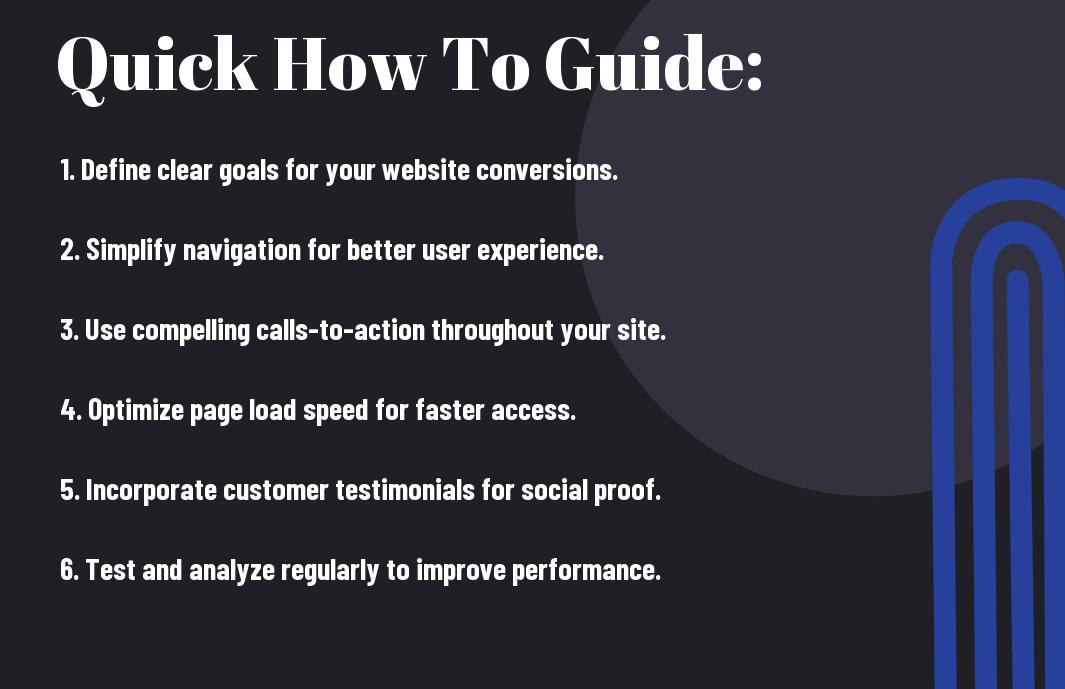Most small business owners are unaware that their website could be a powerful conversion tool waiting to be optimized. In this post, you’ll learn simple yet effective strategies that will enhance user experience, eliminate bottlenecks, and ultimately drive more sales. By implementing these tips, you can transform your website into an engaging platform that resonates with your customers and encourages them to take action. Let’s investigate the crucial steps you can take today to turn your website into a conversion magnet!
Key Takeaways:
- Ensure your website’s design is user-friendly and mobile-responsive to enhance visitor experience.
- Utilize clear and compelling calls-to-action (CTAs) guiding users towards desired actions, such as signing up or making a purchase.
- Leverage analytics tools to track visitor behavior, allowing for continuous optimization of website elements for higher conversion rates.

Understanding Conversions
A conversion occurs when a visitor to your website completes a desired action, such as making a purchase, signing up for a newsletter, or filling out a contact form. These actions are imperative indicators of how effectively your website is engaging and persuading users to take steps that benefit your business.
What Are Conversions?
What defines a conversion can vary based on your business goals. It can be anything from a financial transaction to a visitor downloading a free resource. Essentially, conversions symbolize the successful engagement of your audience, turning passive visitors into active participants in your business.
Why They Matter for Small Businesses
While conversions are important for all businesses, they hold particular significance for small companies striving to maximize limited resources. Your conversion rate reflects how well your website is tailored to your target audience, allowing you to generate more leads and revenue without spending excessively on marketing.
Plus, having a high conversion rate means you can enhance your return on investment through effective marketing strategies. By focusing on conversions, you can minimize wasted efforts and direct your resources toward what truly works for your business. This optimization not only helps build your customer base but also strengthens your brand’s reputation, creating a positive feedback loop that drives further growth.
Key Factors Influencing Conversions
Now that you’re aware of the importance of optimizing your small business website, it’s necessary to consider the key factors that influence conversions. These include:
- Website Design
- Content Quality
- User Experience
- Call-to-Actions
- Mobile Optimization
The right combination of these elements can significantly impact your conversion rates.
Website Design
Conversions will be significantly affected by your website design. A clean, user-friendly layout enhances navigation and encourages visitors to take action, whether that’s filling out a form or making a purchase. Crafting an engaging interface can make your business stand out, instilling trust and motivating potential customers.
Content Quality
Website content plays a vital role in capturing your audience’s attention and driving conversions. High-quality, well-researched, and engaging content resonates with your visitors and establishes your credibility.
It’s imperative that you provide valuable information in an accessible manner, as this keeps your audience engaged. Use clear language and persuasive visuals to enhance understanding and interest. Avoid excessive jargon, which can alienate potential clients. Additionally, incorporate keywords strategically to improve your SEO, attracting more traffic. Ultimately, high-quality content can lead to increased trust and a positive perception of your brand, ultimately resulting in more conversions.
How-to Optimize Your Website
Once again, optimizing your website is necessary to drive conversions effectively. Focus on key elements like user experience, design, and content. By making informed adjustments to these areas, you can significantly enhance your site’s performance and encourage visitors to take the desired actions. Implementing best practices will streamline the user journey and lead to better engagement with your brand.
Crafting Compelling Calls to Action
Assuming you want your visitors to act, crafting compelling calls to action (CTAs) is non-negotiable. Your CTAs should be clear, persuasive, and aligned with the goals of your business, compelling users to click, sign up, or purchase. Use action-oriented language and make sure they stand out visually to capture attention.
Streamlining Navigation
Compelling navigation is a vital aspect of your website’s performance. Ensure that users can easily find what they are looking for without hassle.
Streamlining navigation involves organizing your site’s structure to enhance user experience. Use a clear menu with concise labels to guide visitors effortlessly through your content. Consider implementing a search function so users can quickly locate specific information. Reducing clutter will keep their focus on your necessary offerings, increasing the likelihood of conversions. Always prioritize intuitive layouts to make navigation seamless, as this can profoundly impact engagement and satisfaction.
Tips for Improving User Experience
After enhancing your website’s design, focus on tips that enhance user experience. Consider the following strategies to boost engagement and conversions:
- Streamlined navigation
- Clear call-to-action buttons
- Consistent branding
- High-quality images and content
- Accessible contact information
Perceiving these elements positively affects how visitors interact with your site and can lead to higher conversion rates.
Mobile Responsiveness
Assuming your website is not optimized for mobile devices can severely limit your reach. Today’s consumers rely heavily on their smartphones for browsing. Make sure your site is mobile-responsive, ensuring that it displays correctly across all devices. This approach not only enhances user experience, but it also significantly boosts your visibility in search engine results.
Page Load Speed
Speed is a vital factor in retaining visitors. A website that takes too long to load can lead to higher bounce rates and lesser conversions. The goal should be to achieve a loading time of three seconds or less.
Improving page load speed is imperative for keeping potential customers on your site. Use tools like Google PageSpeed Insights to identify bottlenecks, such as large images or unnecessary scripts, that slow down your site’s performance. Additionally, employing caching strategies and optimizing your code can significantly enhance user experience. Each second counts; prioritizing this aspect of your website can greatly impact your business success.
Effective Use of Analytics
All successful small businesses leverage analytics to enhance website performance and drive conversions. By integrating tools like Google Analytics, you can gain valuable insights into how visitors interact with your site and identify areas for improvement. Understanding your audience’s behavior enables you to make smarter decisions that lead to increased engagement, higher sales, and greater overall success.
Tracking Visitor Behavior
Visitor behavior tracking is important for understanding how users navigate your website. By analyzing metrics such as page views, session duration, and bounce rates, you can pinpoint what draws users in and where they lose interest. This information is instrumental in shaping your content and layout to better meet the needs of your audience.
Making Data-Driven Improvements
One powerful way to enhance your website is by making data-driven improvements based on analytics insights. By continually monitoring your metrics, you can identify trends and patterns that inform strategic changes. This allows you to test different layouts, content types, and calls to action to see what resonates with your audience.
With consistent analysis of your website’s performance, you can foster ongoing enhancements that contribute to growth. Utilizing A/B testing can provide clear comparisons between different versions of your content, revealing which produces the best results. By focusing on this data-driven approach, you can effectively eliminate guesswork and ensure that every change made is informed and purposeful, driving more conversions and enhancing user experience significantly.
Continuous Testing and Adjustments
Unlike a one-time setup, optimizing your small business website for conversions requires an ongoing commitment to testing and adjustments. By continuously analyzing user behavior and performance metrics, you can identify areas that need improvement. This iterative approach not only keeps your website aligned with your audience’s expectations but also ensures that you are always moving towards higher conversions.
A/B Testing Strategies
While it may seem daunting, A/B testing is an efficient way to compare different versions of your web pages. By isolating one variable at a time, such as headlines or calls-to-action, you can accurately measure which elements resonate more with your audience. This method allows you to make informed decisions based on data rather than guesswork.
Implementing Feedback Loops
An effective way to improve your website is by implementing feedback loops. This process involves gathering insights from your website visitors to understand their needs and preferences better.
For instance, you can use surveys or feedback forms to ask users about their experience on your site. This direct input can reveal pain points and opportunities for improvement that you might not have considered. By applying this real-time feedback, you can tweak your content, design, and functionality to create a more engaging and productive experience, ultimately leading to improved conversion rates. Your audience will appreciate that you are listening and making adjustments based on their insights, enhancing their loyalty to your brand.
Conclusion
Upon reflecting, optimizing your small business website for conversions involves a strategic approach that combines user-friendly design, compelling content, and effective calls to action. By implementing the tips outlined, you can create a seamless experience for your visitors that encourages them to engage with your brand and ultimately convert. Regularly analyzing data and adjusting based on performance will ensure your website remains a valuable asset for your business. Take the time to assess and refine, and watch your conversion rates improve significantly.
Q: What are some effective strategies for improving website load time to enhance conversions?
A: To improve website load time, consider the following strategies: 1) Optimize images by compressing them without significant loss of quality, reducing the file size and speeding up loading times. 2) Minimize the use of heavy scripts and unnecessary plugins that can slow down your site. 3) Utilize a Content Delivery Network (CDN) to distribute your website’s content more efficiently across various geographical locations. 4) Enable browser caching to store certain elements of your website in users’ browsers so they don’t have to load them repeatedly. These enhancements can lead to a smoother user experience, ultimately increasing the likelihood of conversions.
Q: How can I improve my website’s call-to-action (CTA) to increase user engagement?
A: Enhancing your call-to-action (CTA) is fundamental for increasing user engagement. Start by ensuring your CTA buttons are prominently placed on the page, using contrasting colors that stand out against your site’s design. Additionally, use clear, action-oriented language that conveys urgency or a benefit, such as “Get Your Free Trial” or “Shop Now.” A/B testing different CTAs can also provide insights into what resonates best with your audience. Lastly, consider adding social proof, like testimonials or trust badges, near your CTAs to reassure visitors about their decision, leading to higher conversion rates.
Q: What role does mobile optimization play in website conversions?
A: Mobile optimization is imperative due to the growing number of users accessing websites via smartphones. To ensure optimal conversions, your website should be responsive, meaning it automatically adjusts its layout and content to different screen sizes. This includes easily readable text, appropriately sized buttons, and fast loading times on mobile devices. Additionally, streamline navigation for mobile users by simplifying menus and eliminating excessive information. With a mobile-friendly site, visitors are more likely to stay engaged, which significantly boosts the chances of conversion.

